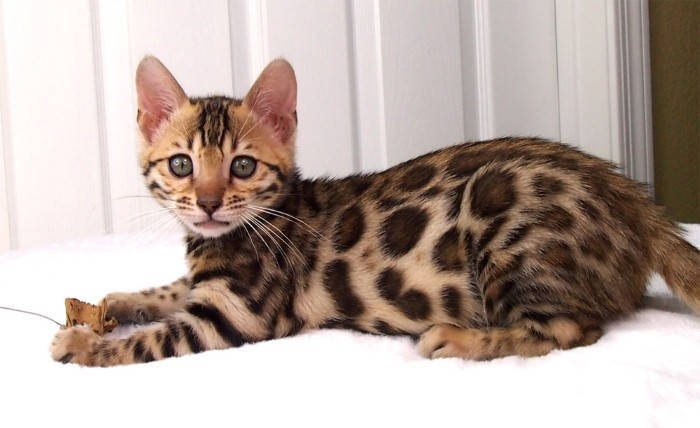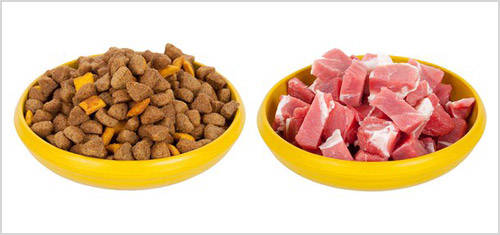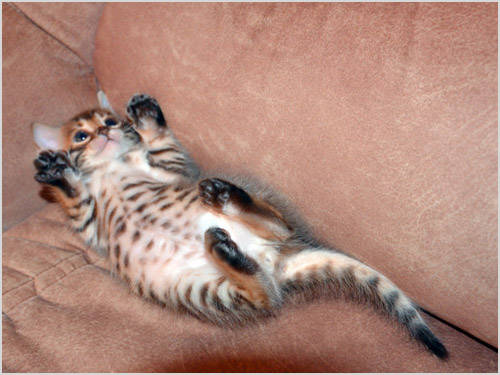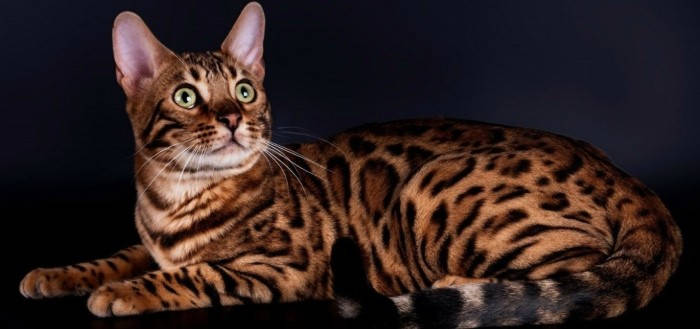Important! According to veterinarians, this type of food is not acceptable for Bengal kittens, as it leads to allergies, intestinal disorders, metabolic disorders.

- The morning does not begin with coffee. Or: How to feed a Bengal kitten correctly.
- Breed characteristics
- Advantages of the breed
- Photo of a Bengal cat
- Basic character traits
- Features of Bengal behavior in the home
- Prepared food or natural food?
- Prepared foods
- Where can I buy the original Bengal cat food at the best prices?
- Three-month-old Bengal food.
- 4 months and older
- Vitamins and supplements
- Water
- Natural Food
- What else should be on a Bengal cat's menu if you choose a natural diet:
- What to look for when buying a Bengal cat
- Forbidden foods
- If food, what kind to choose?
The morning does not begin with coffee. Or: How to feed a Bengal kitten correctly.
2. My Bengal cats are on a natural diet. It's a mix of large pieces of broiler chicken and by-products. The bone part in the mix is mandatory and lifelong (necks or heads, some cartilage, or pieces of sternum). So I have half an hour to wake up, then put the food on plates and spread it around the room.
Cats that eat straight food are said to live longer and get sick less. I, like all of us, love my redheads very much and want to enjoy the companionship of a healthy cat for a long, long time.
But we "go" to the litter box once every 1-1.5 days, and the pile hardly ever stinks. That's a nice bonus with all naturals.
So the first thing we have in the morning is breakfast. And then it's litter box cleaning.
All-all cats like to eat at the same time. Adults have 2 meals a day, and are usually tied to the family's regular office hours.
– Whoever gets home from work first feeds (around 7pm).
Kittens at 3-4 months of age ask for a "night meal." This is 1,5-2 hours before we go to sleep, a time when we drink tea with cookies, etc. After eating, kittens just have time to hang out with toys and lie down to digest all they ate. Then there is less pecking and clattering of toys at night.
Sick, pregnant, kittens at 1-2.5 months I feed 4 times a day. That is, I either stay up late or set the alarm for 2-3 am.
Note: these little kittens are 1 month and 1 week or so old. When feeding NP (natural specimen food), I don't need to introduce complementary foods. The kittens are the age of imitation after their mother. They try licking or sucking the slightly wet catfood; then, after a while, they try it on their teeth, then they try chewing. All like their mother does. At the same time, even if they swallow a couple of pieces, they go and drink it all down with mom's milk. So, my point is: at the age of 1 month, 1.5 months, and often at 2 months, kittens need a mother. Up to 2 months they are 100% suckling mom. To feed a kitten at this age it is quite possible, but you have to do it properly, so as not to damage the "baby's" digestion.
Breed characteristics
How difficult is the breed to care for?
Do Bengals need special nutrition?
What size do they reach?
Aside from color, does the breed have similarities to its wild ancestors?
What is phasing in Bengal cats?
At what age do Bengals acquire the color characteristic of the breed.
Why are kittens of this breed so expensive?
Are Bengals hyperactive cats? Can they live in an apartment and not create chaos around them?
Do Bengals leave "tags" in the house?
Is it true that Bengal cats have a special relationship to water?
They say Bengal cats don't shed. So are they suitable for allergy sufferers?
How does a Bengal cat behave in the house?
Attitude to children, other family members
Attitude to other animals, dogs
Do Bengals need walking?
What sex should I choose as a pet?
How long do Bengal cats live?
Advantages of the breed
- Has an extravagant appearance. It is a real indoor leopard with a good disposition.
- It is a strong, agile animal with a bright hunting instinct.
- The Bengal is an intellectual. He catches everything on the fly and quickly learns to understand his master.
- His ability to train and memorize commands is unique. He is a talented pupil who can be taught to perform a variety of tricks.
- His friendliness and sociability are in his blood. Despite their physical strength, all Bengals are not aggressive. They do not bite or scratch.
- One of the cleanest animals is the Bengal cat. The description of the breed says that they have a silky coat. They take care of it themselves. The pets are bathed very rarely, as a rule, it is done before exhibitions.
- An interesting voice, not like the usual meow. The range of sounds is very wide, from a simple purr to cooing and clicking tongue. Owners note that these sounds resemble barking.
- Larger than most breeds. Average weight reaches – 5-8 kg.
- These cats are excellent jumpers. Thanks to the elongated hind legs, they perform amazing strength jumping in length and height.
Photo of a Bengal cat
A real domestic leopard with an easy-going character, this is a domestic Bengal cat. It has not inherited its character from its wild relatives. From her ancestor remained the color, the love of water and an unusual voice. Otherwise, this animal has all the features of a pet. Its hunting qualities are manifested only in games.
At shows this breed is especially strictly evaluated temperament. Positive marks are given only to calm and affectionate animals. Aggressiveness and aloofness are considered a marriage. Individuals with such traits to breeding are not allowed.
Basic character traits
- Representatives of this breed are intelligent and intelligent, quickly getting used to the litter box and scratching post. Many useful skills are taught simply by observing the behavior of people.
- They are independent and freedom-loving. Do not like to be picked up against their will.
- Bengal singles out one person in the family, to whom they are more attached than to others. They like to watch him. At the same time, they try not to let him out of their sight for a minute.
- Pets are very sociable. Loneliness is not good for them. They become wild and often leave tags on the owner's belongings in retaliation.
- High game activity is maintained until old age. Movable games are interesting to them at any age.
- Guarding qualities are more common in males, especially if they live in a country house. Bengals guard their territory from strange cats.
- Pets do not accept yelling and physical punishment. Any expression of aggression towards them is contraindicated.
- Brightly expressed leadership qualities. If there are other animals in the house, bengal will try to become the head of the pack. When keeping cats of the same sex, fights may occur.
Features of Bengal behavior in the home
- It is an excellent mousetrap. His hunting instinct is very strongly developed. He hunts exactly as his wild relatives, staging ambushes and waiting for the right moment.
- Cautious and calculating is characteristic of the bird. Males will not climb into a fight "upright". Like real hunters, they wait until the opponent will lose vigilance and attack from the back.
- Cats show their emotions with different sounds. A characteristic purr accompanies most meals and tenderness towards owners.
- Not aggressive toward all family members. With strangers behave at first cautiously. Their confidence must be earned.
- They like to play with children. For pets, the child is a good companion for fun. In the game does not show aggression, but it happens that releases claws, as any cat.
- It is a companion animal, the Bengal likes to take part in all household activities.
- Pets are especially active in the mornings and evenings. Their favorite pastime is hide-and-seek.
- Very funny drink water. They wiggle their paws in the water, cleaning the bowl from the imaginary cuss. In the heads of kittens on the program, and they imagine that they drink water at least the river Ganges.
- Genetically, they have another peculiarity in mind. Domestic leopards, like their ancestors, prefer to relieve themselves in water. Therefore, they can easily be taught to go to the toilet.
- They love walking outside. Unlike most breeds, they are well accustomed to the harness and look forward to every outing.
Prepared food or natural food?
Bengal cats can be fed both ready-to-eat, bagged foods and natural foods. The debate between experts as to which method of feeding is preferable does not subside to this day. Many veterinarians advise feeding Bengals only ready-to-eat foods. This option has a lot of advantages, but it is not free from the disadvantages.
- Pre-prepared food provides the animal with a full range of all necessary microelements and, therefore, completely eliminates the risk of a wrong cat's menu.
- The dry food delays tartar buildup and keeps teeth healthy.
- The brightly colored sachets from well-known companies are a real lifesaver for the working person. Flavorful pellets do not spoil in the air, you can pour them in a bowl in the morning and not be afraid that an animal left alone will starve.
- On the other hand, neither dry nor wet canned food fully meets the physiological needs of a cat of prey. On such a diet, these animals get far less liquid than they need. This is especially true for dry food.
- Bengal cats eating prepared foods suffer from obesity much more often than their congeners on a natural diet.

Natural food suits spotted hunters much better, but such a diet also carries many pitfalls. Making a balanced menu from conventional foods is much more difficult than from prepared foods. It is necessary not only to consider the ratio of proteins, carbohydrates and fats, but also to ensure that with food the animal gets all the necessary micronutrients. Natural food, surprisingly enough, requires a mandatory supplement of vitamins.
In addition, there are a large number of foods that are not good for the cat, and foods that are acceptable in very small quantities. And making a meal for your cat with real food takes a lot more time than unpacking a bag of pet food.
Prepared foods
Despite the ads, not all ready-made foods are equally healthy. Only premium cat foods should be given to a Bengal cat. Popular and cheap foods such as Kitikat, Whiskas, Darling or Tomcat are digestible by non-bred Wussies and Purrs, but may cost a Bengal cat their health.
- Hills.
- Royal Kanin (original) for cats.
- Yams.
- Nutra Gold.
- Eagle Pak.
- Acana.
- Other holistic and super-premium foods.
- ULTRA-premium raw natural SUPERPET feeds would be one of the best feeding options for this breed. They are made from lean meats and poultry with the addition of essential vitamins and trace elements.
Of course, these products are not cheap. But if you decided to take in house this breed of cat, it is better to spend money for proper nutrition for Bengal cat, than to pay for expensive medicine and vet visits, watching the suffering of your favorite cat.
If such food is too expensive for the family, you should consider converting the cat to natural food.
Where can I buy the original Bengal cat food at the best prices?
You can buy the best food for Bengal kittens at the best price from the following online pet stores:
 Three-month-old Bengal food.
Three-month-old Bengal food.
By this age, kittens are already starting to transition to adult food. It is necessary to gradually reduce the proportion of dairy products up to 30% and at the same time increase the amount of meat products.
- Natural food should be cut into small pieces, not more than half a centimeter. This is especially true for solid foods such as meat and fish.
- Dry food can be stopped soaking, and canned pates can be given without fear up to 4 and even up to 6 months.
- An excellent option for a three-month-old Bengal would be to feed him natural raw food brand SUPERPET. They are made from natural meat, have an excellent composition and all the necessary vitamins and minerals for kittens. This food is available as minced meat, which is suitable for kittens at the age of 2-3 months, and those who are older, can be given this food in the form of pieces.
4 months and older
Beginning at 13 weeks, milk should be completely removed from the kitten's diet, and the amount of fermented milk products should be reduced to 15 – 20%. But the volume of meat products (turkey, beef, chicken, by-products) will be increased to 60%. The rest of the food will be boiled vegetables and cereals.
Kashi from this age can be given thick, and to boiled vegetables occasionally add some chopped raw carrots, cauliflower or asparagus. All animals have their own food preferences. Try giving your pet different foods to find out what they digest best.
As your kitten grows, the number of meals decreases. At 4 months, up to 4 times a day. At 5 months of age, 3 times a day. And only after one year of age you can transfer a Bengal kitten to the standard two meals a day.
Vitamins and supplements
Vitamins and supplements are given to bengals only at natural nutrition. Veterinarians recommend using complex supplements, nutraceuticals, complexes with biotin. It is also possible to supplement the diet with dried yeast, fish oil, meat and bone meal. Give probiotics and enzyme supplements to improve gastrointestinal function.
Pharmacy vitamin preparations for Bengals come in different forms – capsules, tablets, injections, powders, liquids. What vitamin complex is right for your kitten, tell the veterinarian.
You do not give vitamin complexes if you have a ready-made diet. Quality food contains all the vitamins, minerals and amino acids necessary for health and development.
Water
At any age, regardless of the type of diet of the Bengal, drinking water should always be freely available in the bowl. Do not give your cat tap water. It contains chlorine and other chemicals that are unsafe for animals.
Veterinarians recommend using pre-ground, filtered soft drinking water for drinking by kittens. You can also give bottled artesian water without gas to your kitten.
Always wash bowls before pouring water into them. The water should be changed once or twice a day. Make sure there are no food particles, insects or other foreign particles in the water.
Natural Food
Bengals are true carnivores, so their diet should consist of 70% lean raw meat. To avoid parasite infestation in this type of feeding, the meat is deep frozen.
- Immediately before feeding, the meat is taken out of the freezer, cut into small pieces and scalded with boiling water. There's no need to mince or grind it – the Bengal breed needs a load on its teeth. Meat minced in a meat grinder is only suitable for kittens and older cats.
What else should be on a Bengal cat's menu if you choose a natural diet:
- Liver: lungs, kidneys, heart, liver;
- Bird necks – especially useful during the period of teeth change. How to give properly – free from skin and fat veins, crush with a hammer;
- Frozen sea fish without bones – 1-2 times a month;
- raw quail eggs – once a week. In the wild, cats ravage birds' nests for their favorite treat – eggs;
- raw or boiled vegetables: cauliflower, zucchini, carrots, spinach, pumpkin;
- cereals: buckwheat, buckwheat, rice;
- low-fat cottage cheese; other sour-milk products are eaten without appetite by Bengalis;
- sprouted wheat.
Natural food should be given to the Bengal in the following proportions: 70% raw meat, 15% boiled or fresh vegetables, 5% boiled cereals. The remaining 10% are by-products, eggs, cottage cheese or fish. The portion of an adult Bengal is 200-400 grams. Frequency of feeding – 2-3 times a day.
- Skimmed meat – 50-60% of the ration, necessarily frozen and boiled;
- Raw and boiled vegetables – 20%, except for potatoes, eggplants and beans
- low-fat sour-milk products – up to 20%;
- porridges – up to 7%;
- Boiled fish – no more than once a week;
- Eggs – up to twice a week;
- greens
Water should always be available. And it should always be fresh. Water is given from the tap or purchased from bottles or from a well, clean spring (not boiled).
What to look for when buying a Bengal cat
Before buying a kitten, first decide about your plans about him. If you dream about a show career for your future pet, choose the fluffy cat from the "show" class. The price for them is high, but these kittens are potential champions. For breeding and obtaining quality offspring, it is better to choose "bred" class. And if you're just looking for a pet for fun, buy a pet, the price of which is usually affordable.
Before buying, decide on your plans for the pet. Photo: LElik83 / Shutterstock
In addition to prospects, be sure to pay attention to the pet's health and appearance. The future pet should be active, agile and moderately well-fed. Also, he must be given all age-appropriate vaccinations.
When you make a deal, make sure that you get a package of documents along with the kitten: contract of sale, veterinary certificate, and metric (the cat's "birth certificate"), on the basis of which the pedigree is issued.
If you didn't get any documents, get the vet passport and make sure that the kitten is vaccinated. It is not possible to obtain a pedigree for such an animal, since you do not know who its parents are.
Forbidden foods
As such, there is no list of prohibited products for the Bengal cat. She has inherited a short and sensitive stomach from wild ancestors. For this reason, when drawing up a diet, it is necessary to completely exclude the content of fiber and plant food. All other products should be first introduced into the diet in small portions and observe the behavior of the animal. If there is an individual intolerance of a particular type of food, it should be completely excluded from the diet of the Bengal.
Pork for representatives of this breed is quite fatty, so it should not be introduced into the diet of the animal. It is also necessary to exclude:
Milk is better replaced by kefir or cottage cheese (video from "Mama Gnomov").
If food, what kind to choose?
Cheap dry food is not suitable for the diet of Bengal cats and cats. For the first two weeks after purchase, it is recommended to feed the kitten and adult Bengal the same food he was eating at the breeder. Then you can gradually change the diet, and be sure to monitor the reaction of the pet. Restlessness, frequent scratching and hair loss indicate that allergies are starting to occur. The first time unfamiliar food is given in small portions.
What food is suitable for your pet depends on the characteristics of the animal, its age and sex. If the cat has no individual intolerance you can use:
Type of food and feeding rates are chosen based on the appetite and personal preferences of the animal.







